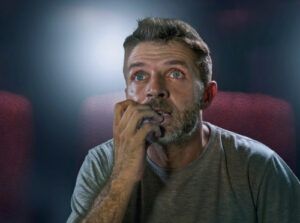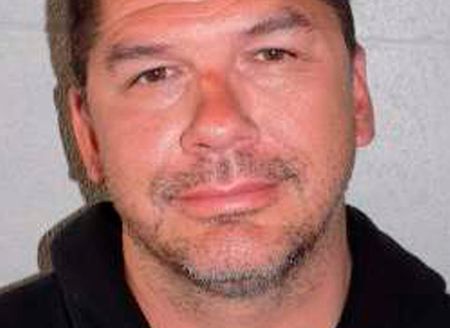Advertisement
Art Imitating Life: Horror Movies Based on Real Events Part Four

Horror movies inspired by real-life crimes and people have been a genre staple for decades. While these movies may be fictionalized accounts of real-life events, they can bring attention to the often horrific and tragic nature of these crimes and their impact on the victims and their families. They can also provide a way to explore themes of fear, power, and the unknown while offering a glimpse into the darker aspects of human nature. This is the final piece in our series of horror movies inspired by real crimes and people.
Borderland
On a trip to a Mexican border town, three college friends stumble upon a human-sacrifice cult.
When a group of close friends go on vacation for Spring Break, the idea is that they come back with some wild stories and good memories. This was not the case for one American college student.
Before talking about the crime that inspired this film, we have to go back and talk about the antagonist of the story. Adolfo Constanzo was a Cuban American who, in early life, got in trouble for small offenses such as shoplifting, vandalism, and theft. Adolfo became known to the world as a practitioner of Palo Maymobe and the leader of a cult called Narcostatanists (who were mainly involved in drug trafficking and human sacrifices).
Palo Maymobe, like Santeria, is an Afro-Caribbean religion. In Adolfo’s youth, his mother, a priestess of Palo Maymobe, introduced him to the alternative practices of the religion. His mother would regularly sacrifice small animals, and Adolfo himself would steal human bones from graves for rituals. Followers of Palo Maymobe are often blamed for grave robbing, including stealing bones and body parts.
Constanzo moved to Mexico City in 1983, making a living reading tarot cards and charming people. Adolfo was openly bisexual and recruited two men to be his servants and lovers, Martin Quintana Rodrigues and Omar Chewe Orea Ochoa. After establishing a role in his community, he began to build a cult with a wide array of members, from drug dealers, to musicians and even members of law enforcement. Constanzo’s charisma and good looks earned him respect and status, and he was nicknamed El Padrino (The Godfather).
The cult would engage in activities such as selling drugs and holding occult ceremonies. The group would regularly murder people for human sacrifices, and Constanzo believed that the greater the sacrifice, the greater the power. The rituals were meant to give the cult respect and shield them from law enforcement. The first victims were rival gang members and drug dealers. The bodies would be boiled in an iron cauldron, and cult members would drink the brew from bodily fluids. Members would even go further and make necklaces out of the vertebrae of some victims.
The most famous victim of the Narcostatanists was Mark Kilroy. The college co-ed was visiting towns along the Mexican-American border during Spring Break of 1989 when he was kidnapped while bar hopping. The short story of what happened to the American student is that his body was burned and dismembered, but the actual truth is far more gruesome.
Mark Kilroy’s final hours were not merciful. Kilroy was tortured and sodomized before his death, and he was slain by Constanzo himself with a machete chop to the head. His skull was split over so his brain and spinal column were removed for ritual use. While Kilroy was not the only person to face this terrible fate at the hands of Constanzo and his cult, if not for Kilroy’s familiar connections, he, too, would have faded in the background as another faceless victim.
Mark Kilroy’s uncle was a special agent for the U.S. Customs Service. While that may not sound fancy, it came with the perk of being able to launch an investigation between the United States and Mexico after the disappearance of his nephew.
What really shined a light on the cult is not that they got caught in one of their rituals; it was actually a member of the cult, who was a member of the cartel, who blew through a drug checkpoint. While in custody, the drug dealer started talking about Constanzo’s murder cult and their involvement in the kidnapping and Satanic rituals and that the hideout they used was also the place where the drugs were stored. The police originally busted the hideout as part of a drug raid, and on the premises, they found up to fifteen bodies on the ranch.
After hearing the news of the police raid on the evil ranch, Constanzo and other members escape to Mexico City. Once the law caught up with them, Constanzo had a forty-five-minute shootout with law enforcement. Adolfo Constanzo ordered cult member Alvarode Leon Valdez to shoot him and lover Martin Quintana Rodriguez to avoid being arrested. Constanzo died via a gunshot wound, never going to trial for his crimes.
The Sacrament
A news team travels to a religious settlement to find a man’s missing sister, but the paradise is not what it seems.
This film is not subtle in its representation of the events at Jonestown on November 18th, 1978. The terror at Jonestown marks the largest mass suicide event in modern history, where the phrase “Don’t drink the Kool-Aid” originated. Known as the Peoples Temple, the cult suicide involved the death of over nine hundred people, about three of whom were people under seventeen.
Jim Jones started his church (cult) in the 1950s in Indianapolis. Jones’ church stood out during this time as it had no ties to any distinct denomination, and his congregation was known for being racially integrated, which was very out of the norm. While Jones had no theological training or degree, he became ordained in the church in the 1960s.
Jim Jones was very strange and stood out from other ministers of the time. He claimed to have supernatural powers, such as reading minds and performing faith-based healing. This trick made him particularly popular with politicians. Along with claiming to have psychic powers, Jones also was said to call himself Prophet and told his followers that he was a messiah.
Jones was very outspoken about his passion for humanitarian causes, but the rumors from those in and around his congregation tell a different story. There were allegations that Jones would mistreat his followers, and members would be beaten, humiliated, and even blackmailed. Numerous members were brainwashed by Jones to sign over possessions and property, and family members were encouraged to inform each other. There is evidence that Jones illegally diverted the income of cult members for personal use. Not only were there stories of physical abuse going on, but also that Jones was controlling his congregation with the use of drugs, forced labor, and there were suspicious deaths of those in his inner circle.
Jones was known for being extremely paranoid, and at one point, he moved his congregation to the outside of Ukiah, California, in order to escape a nuclear holocaust. More than likely, the real reason was so that his church members could be isolated from outside influences, and he could mistreat them in private.
His need for control was so great that he found land in Guyana to build a little utopia for himself and his followers (or perhaps it was a way to escape the press and their questions about the church). The compound was extremely remote and self-governed, away from watchful eyes. The rumors surrounding the Peoples Temple did not stop with the move around continents. Stories of members suffering psychological and physical abuse still persisted, and now there was news that followers were being held against their will within the compound. There was reason to believe Jones built this “Eden” through forced labor. Jones was obsessed with power.
The stories of abuse were so intense that even overseas, the U.S. government couldn’t overlook the potential environment their citizens were in. On November 17th, 1978, U.S. Congressman Leo Ryan visited the compound to find out the truth for himself. During Ryan’s time in Guyana, several members of the Peoples Temple expressed wanting to return to the States with Ryan, saying they were being imprisoned to stay in Jonestown against their will. Not only was the theme of imprisonment a concern but there were also stories that the people in Jonestown held rehearsals for the event of mass suicide.
The next day, on the 18th, is the day that went down in history. Before leaving the compound, there was infighting as the members who wished to leave were being pressured to stay. While trying to leave, members of the Peoples Temple attacked Ryan’s vehicle with firearms; however, the Congressman was able to escape. Ryan and staff, along with members of the Peoples Temple who wished to leave, were at the airstrip that only contained a single helicopter that would have needed to have made multiple trips. The armed members of the Peoples Temple with weapons had followed them to the airstrip and opened fire on the Congressman and other innocent bystanders again. Ryan and three press members who had accompanied him were shot and killed.
Once a U.S. Congressman was killed by his people, Jones knew there was no going back. He ordered members to drink a Kool-Aid concoction laced with cyanide, tranquilizers, and sedatives. The children and babies were the first to receive the poison; the fluid was administered via syringes. Fewer than one hundred members survived the horrible event. Jim Jones himself was too much of a coward to go out in the slow and painful manner he forced on his precious followers and took the coward’s way out by shooting himself with a gun. Until 9/11, Jonestown was known as the largest number of American civilian casualties in a non-natural event.
The Girl Next Door (2007)
Follows the unspeakable torture and abuses committed on a teenage girl in the care of her aunt and the boys who witness and fail to report the crime.
Children being abused to the point of death is nothing new, but this case was bizarre because pretty much the entire neighborhood knew about the abuse, and everyone took part in it.
In 1965, sixteen-year-old Sylvia Likens and her siblings came from a poor family. Their parents, who had no formal education or marketable skills, worked several odd jobs to make ends meet. Sylvia’s parents were carnival workers and always on the road. During that particular summer, Sylvia’s mother was in jail for shoplifting. Since the parents were always on the road, Sylvia and her younger sister, Jenny, needed someone to live with while their parents worked. Gertrude Baniszewski agreed to look after the girls for twenty dollars a week.
Gertrude Baniszewski was an elderly woman with six children of her own, but she was no sweet little grandmother. Gertrude was poor, depressed, and on a lot of prescription drugs. She had been divorced several times, and in her past relationships, there was physical abuse. While it’s unknown how her relationship with her own children was, Gertrude was anything but kind to the young, vivacious, and pretty Sylvia.
Gertrude did not take long to show her true colors to the Likens girls. Two weeks after being with Gertrude, the money order for the Likens children came late. Angry over this, Gertrude dragged Jenny and Sylvia upstairs, slapping the girls in the face and saying, “I took care of you two bitches for a week for nothing.” Gertrude then took Sylvia into a room privately to beat her more while Jenny listened to the beating through the door. The money order came in the mail the next day. This was only the beginning of Sylvia’s hell while in the elderly woman’s care.
Gertrude had a thick leather belt and paddle for disciplining the children, but she was much more creative with punishing Sylvia for any transgression. At one point, she accused Sylvia of stealing from her and used matches to burn Sylvia’s fingertips. She would even force Sylvia to overeat and then consume her vomit after Sylvia threw up. Gertrude would take the time to cut Sylvia’s skin so the old woman could literally rub salt in the wounds.
Not only did Gertrude abuse children who were not her own, she encouraged others to join in. Gertrude’s seventeen-year-old daughter, Paula, never got along with Sylvia and was all too willing to participate in hurting the younger girl. Gertrude would give sermons about the sins of sex while Paula stomped on Sylvia’s vagina, then Sylvia was forced to bathe in scalding hot water in order to wash off her sins. John Baniszewski, one of Gertrude’s older children, made Sylvia lick his little brother’s soiled diapers. Jenny Likens would also be forced into abusing her sister, lest she be on the receiving end of the torture.
The story of Sylvia Likens’ horrible life was not kept secret, as the children in the neighborhood were well aware of the horrors happening in the Baniszewski home since they joined in as well. The kids would practice judo on Sylvia by throwing her against the walls, kicking and beating Sylvia, and even putting out cigarettes on her skin, all at the expense and encouragement of Gertrude. At one point, the children and Gertrude made Sylvia undress and insert a Coke bottle into her vagina.
Sylvia’s body was starting to deteriorate with the abuse she was taking. She started to wet the bed, which was a clear sign of abuse and distress at her age. At least a dozen neighborhood children were aware of the abuse happening to Likens (since most of them participated in the torture for months), and none of them ever spoke a word about it to their parents or the authorities. Adults would see Sylvia’s skeletal and beaten body walk around town, but no one would question her safety with the psychotic Gertrude Baniszweski.
At the end of her life, Sylvia Likens was locked in the basement with only a mattress and no access to the toilet or any food. On October 26th, 1965, Indianapolis police found Sylvia’s malnourished body in the basement, where she was left to rot. Her youthful body was covered in bruises, scars, and burns that only occurred after being taken into Gertrude’s care. On her abdomen, someone had branded the phrase “I am a prostitute.” Sylvia died from brain swelling, internal brain hemorrhaging, and shock.
At first, Gertrude tried telling the police that Sylvia was very loose and had been hanging out with a gang of teenage boys that had beaten her. However, the damage caused to the body, plus the different stages of healing her wounds, showed the beating and abuse took place over a long time. There was no way Sylvia could have had that much damage from one beating session.
At the trial, Gertrude claimed to be ignorant of the abuse, fully blaming her own children for the abuse Sylvia underwent. Gertrude pleaded not guilty by reason of insanity due to her long history of depression. In May 1966, Gertrude was found guilty of first-degree murder. Paula was found guilty of second-degree murder, and both women were sentenced to life in prison. John and two others were found guilty of manslaughter due to their connection to the crime.
While a healthy imagination is a wonderful thing to have, these horror movies would not be the icons today if real-life events did not bleed into the storyline a little bit. The elements of these true crimes can be unnerving, but presenting them in movie format is a way to share the story of what happened and explore the darker nature of the human mind. A little scare occasionally is good for the nerves, and horror movies are the perfect way to embrace our sinister side. Thank you for reading this short series.













